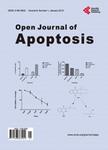BAX G(-248)A Gene Polymorphism and Its Association with Risk of Non-Small Cell Lung Cancer—A Case Control Study
BAX G(-248)A Gene Polymorphism and Its Association with Risk of Non-Small Cell Lung Cancer—A Case Control Study作者机构:Department of Biochemistry Maulana Azad Medical College and Associated Hospitals New Delhi India Prince Fahd Bin Sultan Research Chair Faculty of Applied Medical Sciences University of Tabuk Tabuk Saudia Arabia Department of Radiotherapy and Oncology All India Institute of Medical Sciences New Delhi India
出 版 物:《Open Journal of Apoptosis》 (细胞凋亡(英文))
年 卷 期:2015年第4卷第2期
页 面:47-58页
学科分类:1002[医学-临床医学] 100214[医学-肿瘤学] 10[医学]
主 题:BAX G(-248)A Polymorphism PIRA-PCR NSCLC Risk
摘 要:Pro-apoptotic Bcl-2 protein BAX is an important member of mitochondrial dependent apoptosis regulation and ultimately plays a pivotal role in malignancies. A promoter G(-248)A polymorphism in the TP53 binding region of BAX results in differential binding capacity of TP53 protein there by regulating its expression, which has been found to be associated with different clinical outcomes in various malignancies. Presently we aimed to analyze the possible impact of the BAX G(-248)A polymorphism on the risk and other clinical features of non-small cell lung cancer in Indian population. The BAX promoter polymorphism was analyzed in blood samples of 320 subjects with 1:1 case/control ratio by primer-introduced restriction analysis PCR and survival curves were plotted using Kaplan-Meier analysis. It was observed that more than 3-fold increased risk of developing non-small cell lung cancer was associated with homozygous AA genotype of BAX G(-248)A promoter polymorphism in Indian population, with more predominant in smokers with pack-year 45 (heavy) and using cigarette or huka as their smoking source than homozygous GG genotype. Significant associations was observed between TNM stage (p = 0.037) and histological type (0.02), of non-small cell lung cancer patients with the polymorphism. Patients homozygous for A allele exhibited a significant poor overall survival compared with patients displaying GA + AA or GA or GG genotype [median survival 6.0 vs 9.0, 11.0, and 30.0 months, respectively (p 0.0001)]. Adenocarcinoma and advanced stage patients with AA genotype showed lower median survival time than squamous cell carcinoma and early stage non-small cell lung cancer patients (median 3.0 and 5.0 vs 8.0 and 9.0 months, respectively). We conclude that the genetic polymorphism G(-248)A in the TP53 binding promoter region of pro-apoptotic genes BAX may contribute to the risk of developing non-small cell lung cancer in Indian population and also may be an important factor for adve



